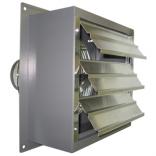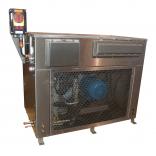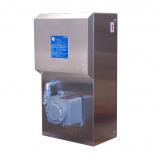Frequently Asked Questions
What is ISO 9001:2008?
ISO 9001:2008 sets out the criteria for a quality management system and is the only standard in the ISO family that can be certified to.
The standard is based on a number of quality management principles including a strong customer focus, the motivation and implication of top management, the process approach and continual improvement. Using ISO 9001:2008 helps ensure that customers get consistent, top quality products and services, which in turn brings many business benefits.
What does "Explosion Proof" mean?
The National Electrical Code (NEC) defines hazardous locations as those areas "where fire or explosion hazards may exist due to flammable gases or vapors, flammable liquids, combustible dust, or ignitable fibers or flyings."
A substantial part of the NEC is devoted to the discussion of hazardous locations. That's because electrical equipment can become a source of ignition in these volatile areas. Articles 500 through 504, and 510 through 517 provide classification and installation standards for the use of electrical equipment in these locations. The writers of the NEC developed a short-hand method of describing areas classified as hazardous locations. One of the purposes of this discussion is to explain this classification system. Hazardous locations are classified in three ways by the National Electrical Code: TYPE, CONDITION, and NATURE.
Hazardous Location Types
Class I Locations
According to the NEC, there are three types of hazardous locations. The first type of hazard is one which is created by the presence of flammable gases or vapors in the air, such as natural gas or gasoline vapor. When these materials are found in the atmosphere, a potential for explosion exists, which could be ignited if an electrical or other source of ignition is present. The Code writers have referred to this first type of hazard as Class I. So, a Class I Hazardous Location is one in whichflammable gases or vapors may be present in the air in sufficient quantities to be explosive or ignitable. Some typical Class I locations are:
- Petroleum refineries, and gasoline storage and dispensing areas;
- Dry cleaning plants where vapors from cleaning fluids can be present;
- Spray finishing areas;
- Aircraft hangars and fuel servicing areas; and
- Utility gas plants, and operations involving storage and handling of liquified petroleum gas or natural gas.
- All of these are Class I . . . gas or vapor . . . hazardous locations. All require special Class I hazardous location equipment.
-
- Grain elevators;
- Flour and feed mills;
- Plants that manufacture, use or store magnesium or aluminum powders;
- Producers of plastics, medicines and fireworks;
- Producers of starch or candies;
- Spice-grinding plants, sugar plants and cocoa plants; and
- Coal preparation plants and other carbon handling or processing areas.
-
- Textile mills, cotton gins;
- Cotton seed mills, flax processing plants; and
- Plants that shape, pulverize or cut wood and create sawdust or flyings.
-
- It must seal out the dust.
- It must operate below the ignition temperature of the hazardous substance.
- It must allow for a dust blanket. That is, the build-up of dust collecting on top of the device that can cause it to run "hot" and ignite the surrounding atmosphere.
- Arcs and sparks
- High temperatures
- Electrical equipment failure
Hazardous Location Conditions
In addition to the types of hazardous locations, the National Electrical Code also concerns itself with the kinds of conditions under which these hazards are present. The Code specifies that hazardous material may exist in several different kinds of conditions which, for simplicity, can be described as, first, normal conditions, and, second, abnormal conditions.
In the normal condition, the hazard would be expected to be present in everyday production operations or during frequent repair and maintenance activity.
When the hazardous material is expected to be confined within closed containers or closed systems and will be present only through accidental rupture, breakage or unusual faulty operation, the situation could be called "abnormal."
The Code writers have designated these two kinds of conditions very simply, as Division 1 - normal and Division 2 - abnormal. Class I, Class II and Class III hazardous locations can be either Division 1 or Division 2.
Good examples of Class I, Division 1 locations would be the areas near open dome loading facilities or adjacent to relief valves in a petroleum refinery, because the hazardous material would be present during normal plant operations.
Closed storage drums containing flammable liquids in an inside storage room would not normally allow the hazardous vapors to escape into the atmosphere. But, what happens if one of the containers is leaking? You've got a Division 2 -abnormal - condition . . . a Class I, Division 2 hazardous location.
So far we've covered the three types of hazardous locations:Class I - gas or vapor
Class II - dust, and
Class III - fibers and flyings.And secondly, kinds of conditions:
Division 1 - normal conditions, and
Division 2 - abnormal conditions.Now let's move on to a discussion of the nature of hazardous substances.
Nature of Hazardous Substances
The gases and vapors of Class I locations are broken into four groups by the Code: A, B, C, and D. These materials are grouped according to the ignition temperature of the substance, its explosion pressure, and other flammable characteristics.
The only substance in Group A is acetylene. Acetylene makes up only a very small percentage of hazardous locations. Consequently, little equipment is available for this type of location. Acetylene is a gas with extremely high explosion pressures.
Group B is another relatively small segment of classified areas. This group includes hydrogen and other materials with similar characteristics. If you follow certain specific restrictions in the Code, some of these Group B locations, other than hydrogen, can actually be satisfied with Group C and Group D equipment.
Group C and Group D are by far the most usual Class I groups. They comprise the greatest percentage of all Class I hazardous locations. Found in Group D are many of the most common flammable substances such as butane, gasoline, natural gas and propane.
In Class II - dust locations - we find the hazardous materials in Groups E, F, and G. These groups are classified according to the ignition temperature and theconductivity of the hazardous substance. Conductivity is an important consideration in Class II locations, especially with metal dusts.
Metal dusts are categorized in the Code as Group E. Included here are aluminum and magnesium dusts and other metal dusts of similar nature.
Group F atmospheres contain such materials as carbon black, charcoal dust, coal and coke dust.
In Group G we have grain dusts, flour, starch, cocoa, and similar types of materials.Review
Let's quickly review. Hazardous locations are classified in three ways by the National Electrical Code: TYPE, CONDITION, and NATURE.
There are three types of hazardous conditions: Class I - gas and vapor, Class II - dust, and Class III - fibers and flyings.
There are two kinds of hazardous conditions: Division 1 - normal, and Division 2 - abnormal.
And finally, there is the nature of the hazardous substance . . . where we find Groups A, B, C, and D in Class I locations, and, in Class II locations: Groups E, F, and G.
Let's illustrate our Code "translation" with an example. How would we classify a storage area where LP gas is contained in closed tanks? LP gas is a Class I substance (gas or vapor). It's Division 2 because it would only be in the atmosphere if an accidental rupture or leakage occurred, and it is Group D material.
The table below summarizes the various hazardous (classified) locations.Summary of Class I, II, III Hazardous Locations CLASSES GROUPS DIVISIONS 1 2 I Gases, vapors, and liquids
(Art. 501)A: Acetylene
B: Hydrogen, etc.
C: Ether, etc.
D: Hydrocarbons, fuels, solvents, etc.Normally explosive and hazardous Not normally present in an explosive concentration (but may accidentally exist) II Dusts
(Art. 502)E: Metal dusts (conductive,*and explosive)
F: Carbon dusts (some are conductive,* and all are explosive)
G: Flour, starch, grain, combustible plastic or chemical dust (explosive)Ignitable quantities of dust normally are or may be in suspension, or conductive dust may be present Dust not normally suspended in an ignitable concentration (but may accidentally exist). Dust layers are present. III Fibers and flyings
(Art. 503)Textiles, wood-working, etc. (easily ignitable, but not likely to be explosive) Handled or used in manufacturing Stored or handled in storage (exclusive of manufacturing) *NOTE: Electrically conductive dusts are dusts with a resistivity less than 105 ohm-centimeter.
Hazardous Location Equipment
Sources of Ignition
Now that we've completed our Code translation, we're ready to move to the next part of our discussion - hazardous location equipment. To do this, let's first take a look at the ways in which electrical equipment can become a source of ignition. There are three of them.
Arcs and sparks produced by the normal operation of equipment, like motor starters, contactors, and switches, can ignite a hazardous location atmosphere.The high temperatures of some heat-producing equipment, such as lamps and lighting fixtures, can ignite flammable atmospheres if they exceed the ignition temperature of the hazardous material. The National Electrical Code requires special marking of heat - producing equipment with temperatures above 100oC (212oF).
Electrical equipment failure is another way an explosion could be set off. A burn out of a lamp socket or shorting of a terminal could spark a real disaster in a hazardous location.
Equipment Design and Construction
Now let's get down to specific hardware and how it is designed and constructed to be suitable for hazardous locations . . . starting with those designed for Class I . . . gas or vapor . . . applications.
The first requirement for a Class I enclosure is strength. The enclosure must be strong enough to contain an explosion within. The walls must be thick enough to withstand the internal strain. It has to be explosion-proof in case gas or vapors get inside. Secondly, it must function at a temperature below the ignition temperature of the surrounding atmosphere.
The equipment must also provide a way for the burning gases to escape from the device as they expand during an internal explosion; but, only after they have been cooled off and their flames "quenched." This escape route for the exploding gases is provided through several types of flame paths.
One type is the ground surface flame path. Here the surfaces are ground, mated, and held to a tolerance of 15 ten-thousandths of an inch. This permits gases to escape, but only after they've been sufficiently cooled, so they won't ignite the volatile surrounding atmosphere.
Another kind of flame path is the threaded flame path. After an explosion, the gas travels out the threaded joint . . . but as it does, it cools off.
Exploded gases may also escape around the shafts of operators used in the enclosure. But, here again, close tolerances are used to quench the burning gas.In designing equipment for Class I, Division 1 locations, it is assumed that the hazardous gases or vapors will be present and eventually seep into the enclosure, so there is a very real chance for an internal explosion to occur.
In the case of Class II, however, the assumptions are different and so the design is different. In Class II, the explosive dust is kept away from equipment housed within the enclosure so that no internal explosion can take place and there is no longer any need for heavy explosion-containing construction, or flame paths. This difference explains why Class I, Division 1 equipment can be called explosion-proof, and Class II equipment is called dust-ignition proof. Class II equipment has a different set of requirements:For Class III equipment, there is very little difference in the design from Class II. Class III equipment must minimize entrance of fibers and flyings; prevent the escape of sparks, burning material or hot metal particles resulting from failure of equipment; and operate at a temperature that will prevent the ignition of fibers accumulated on the equipment.
There are many enclosures, devices, and fixtures suitable for all three classes. This simply means that it meets the specifications for each individual type. A Class I device which could contain an explosion of a specified gas would also have to prevent dust from entering the enclosure to be suitable for Class II. The close tolerance of the flame path which cools the burning gases is also close enough to exclude explosive dust so that a gasket would not be needed.
Proper installation of hazardous location equipment calls for the use of seals. Special fittings are required to keep hot gases from traveling through the conduit system igniting other areas if an internal explosion occurs in a Class I device. They are also needed in certain situations to keep flammable dusts from entering dust-ignition-proof enclosures through the conduit.Sealing fittings are designed to be filled with a chemical compound after the wires have been pulled. As the compound hardens, it seals passageways for dusts and gases. As shown in the figure below, in each conduit run entering an enclosure for switches, circuit breakers, fuses, relays, resistors, or other apparatus which may produce arcs, sparks, or high temperatures within Class I locations, conduit seals shall be placed as close as practicable and in no case more than 18 inches (457 mm) from such enclosures. Again, consult the Code for specific rules for the use of seals.
Rigorous standards for hazardous location equipment have been set. Nationally Recognized Testing Laboratories conduct actual explosion tests under laboratory conditions. For each Class I enclosure they experiment with different mixtures of gas and air . . . from very lean mixtures (a small percentage of gas) to very rich mixtures (a high percentage of gas) until they find the one that creates the greatest explosion pressure. To pass inspection, the equipment must not only prevent the ignition of the surrounding atmosphere, but also be able to withstand a hydrostatic test where oil is pumped into the enclosure at high pressure to test the limits of its strength. The device will not pass unless it can resist rupture at four times the maximum pressure found in the explosion tests. For example, if explosion testing shows a maximum pressure for a junction box of 250 pounds per square inch (psi), to get approval, the box must be able to withstand 1,000 psi of hydrostatic pressure - FOUR TIMES the maximum anticipated pressure of 250 psi.
Summary
Regardless of the cause of a hazardous location, it is necessary that every precaution be taken to guard against ignition of the atmosphere. Electrical equipment can be a potential source of ignition through one of three ways:
Hazardous location equipment is designed and constructed to eliminate the potential for ignition of the atmosphere.
The National Electrical Code is the "Bible" of the Electrical Industry, and the primary source of reference for hazardous locations. The NEC is also the basis for OSHA standard 1926.407, Hazardous (Classified) Locations. There are several OSHA standards that require the installation of electrical wiring and equipment in hazardous (classified) locations according to the requirements of Subpart K, Electrical. The NEC should be consulted as a supplement to the OSHA standards for additional background information concerning hazardous locations.
Class III Locations
Class III hazardous locations, according to the NEC, are areas where there are easily-ignitable fibers or flyings present, due to the types of materials being handled, stored, or processed. The fibers and flyings are not likely to be suspended in the air, but can collect around machinery or on lighting fixtures and where heat, a spark or hot metal can ignite them. Some typical Class III locations are:
Class II Locations
The second type of hazard listed by the National Electrical Code are those areas made hazardous by the presence of combustible dust. These are referred to in the Code as "Class II Locations." Finely pulverized material, suspended in the atmosphere, can cause as powerful an explosion as one occurring at a petroleum refinery. Some typical Class II locations are:












